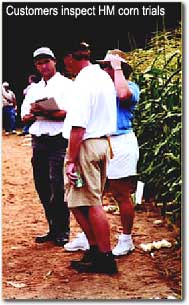|
Races of rust in 2000
Whether or not Rp1-D-virluent races would be a problem
in North America in 2000 and subsequent years depended on whether virulent races
occurred in Mexico where P. sorghi overwinters. In March 2000, virulent
races were found in Harris Moran sweet corn trials in Los Mochis, Mexico. Genes
that were effective against the new North American races of rust in 1999 were
effective in the Mexican trials, but the Rp1-D gene and several other Rp
genes were not effective.
The population of P. sorghi in the Los Mochis
trial was comprised predominantly of isolates of rust that were virulent against
Rp1-D. Heavy dews created a rust-favorable environment that resulted in
nearly 50% of the leaf area infected on Rp1-D-resistant hybrids with a
rust susceptible background. Rust severity was only about 20% on Rp1-D-resistant
hybrids with a moderately resistant background.
By mid-summer, Rp1-D-virulent rust
was widespread throughout most of North America. In the
University of Illinois sweet corn hybrid disease nursery
in Urbana, IL, the severity of rust on Rp1-D-resistant
hybrids was only about half of that on non-Rp versions of the same hybrids.
|
Rust severity ranged from about 5% to
15% on Rp1-D-resistant hybrids with moderate
backgrounds and from about 15% to 30% on Rp1-D-resistant
hybrids with susceptible backgrounds.
In comparison, rust
severity in these trials ranged from about 15% to 60% on
sweet corn hybrids that did not have the
Rp1-D gene. In contrast, Rp1-D-virulent races
were prevalent in populations of P. sorghi in New
York and Ontario, Canada where rust was equally severe on
sweet corn hybrids with and without the
Rp1-D gene.
 |